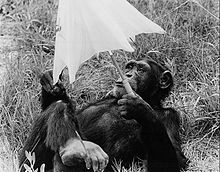Ivan Tors
Ivan Tors | |
|---|---|
 1960 photo | |
| Born | Iván Törzs (1916-06-12)June 12, 1916 Budapest, Austria-Hungary |
| Died | June 4, 1983(1983-06-04) (aged 66) Mato Grosso, Brazil |
| Years active | 1946–1980 |
| Spouse(s) | Constance Dowling (1955–1969) (her death) (4 children) |
Ivan Tors (born Iván Törzs; June 12, 1916 in Budapest, Hungary – June 4, 1983 in the Brazilian state of Mato Grosso) was a Hungarian playwright, film director, screenwriter, and film and television producer with an emphasis on non-violent but exciting science fiction, underwater sequences, and stories involving animals. He started a Miami-based film studio now known as Greenwich Studios,[1] and later a music company.[2]
Contents
1 Biography
2 Personal life
3 Legacy
4 Notes
5 External links
Biography
Tors wrote several plays in his native country Hungary before moving to the United States just prior to World War II. He arrived with his brother Ervin in July 1939 on the SS Hansa and had come to study at Fordham University in New York City. He subsequently enlisted in the United States Army Air Corps then transferred to the Office of Strategic Services.[3] Following the war he was contracted to Metro-Goldwyn-Mayer as a screenwriter.
In 1952 he made Storm over Tibet, his first film as co-writer and producer. He began his partnership with his fellow Hungarian Andrew Marton with this film reusing much of Marton's footage from Demon of the Himalayas.
Long interested in fact-based science fiction, often with an underwater setting, Tors partnered with actor Richard Carlson in the 1950s to create A-Men Films, a production company devoted to making movies about its own fictitious exploits.
Under the A-Men banner, Tors wrote and produced films such as The Magnetic Monster (1951) reusing footage from the 1934 German film Gold, Riders to the Stars (1954), Gog (1954) and the television series Science Fiction Theatre, Sea Hunt, starred Lloyd Bridges, and The Aquanauts, starred Keith Larsen, Jeremy Slate, and Ron Ely, later renamed Malibu Run. He also created the NBC's science fiction series The Man and the Challenge, starred George Nader and Jack Ging and was the executive producer of Ripcord, starred Larry Pennell and Ken Curtis.
His Office of Scientific Investigation (OSI) trilogy consisted of The Magnetic Monster, Riders to the Stars, and Gog, already mentioned.
Tors also produced two Korean War films, Battle Taxi (1955) and Underwater Warrior (1958).

Judy the Chimp, who was a regular on Daktari, also had a role in Jambo.
In the 1960s Tors left science fiction and concentrated on making films and television series involving animals. He typically would make a film first and then develop a television series based on the film. His animal films included Flipper (1963), Flipper's New Adventure (1964), Zebra in the Kitchen (1965), Clarence, the Cross-Eyed Lion (1965), Gentle Giant (1967), and Africa Texas Style (1967). He also directed Rhino! (1964), and Galyon (1977).
His animal-themed television adventure series included Flipper, Daktari, Gentle Ben, Cowboy in Africa, and Jambo, a documentary series set in Africa; he was also the executive producer of MGM Television's 1967 TV series Off to See the Wizard for ABC.[4]
His production company, Ivan Tors Films, did the underwater filming for the James Bond film Thunderball as well as filming his own Around the World Under the Sea for MGM and Daring Game and Hello Down There for Paramount. Tors' studio also filmed Soupy Sales' film debut in Birds Do It.
Personal life
Tors was married to film actress Constance Dowling from 1955 until her death in 1969. Tors died 14 years later, eight days before his 67th birthday. He died in Mato Grosso, Brazil, where he was scouting a new television series.
Legacy
In 1989 the Academy of Underwater Arts & Sciences posthumously awarded Tors a NOGI Award in Arts.
Notes
^ "Greenwich Studios: History". Greenwich Studios. 2013. Archived from the original on November 5, 2015. Retrieved April 30, 2015..mw-parser-output cite.citation{font-style:inherit}.mw-parser-output q{quotes:"""""""'""'"}.mw-parser-output code.cs1-code{color:inherit;background:inherit;border:inherit;padding:inherit}.mw-parser-output .cs1-lock-free a{background:url("//upload.wikimedia.org/wikipedia/commons/thumb/6/65/Lock-green.svg/9px-Lock-green.svg.png")no-repeat;background-position:right .1em center}.mw-parser-output .cs1-lock-limited a,.mw-parser-output .cs1-lock-registration a{background:url("//upload.wikimedia.org/wikipedia/commons/thumb/d/d6/Lock-gray-alt-2.svg/9px-Lock-gray-alt-2.svg.png")no-repeat;background-position:right .1em center}.mw-parser-output .cs1-lock-subscription a{background:url("//upload.wikimedia.org/wikipedia/commons/thumb/a/aa/Lock-red-alt-2.svg/9px-Lock-red-alt-2.svg.png")no-repeat;background-position:right .1em center}.mw-parser-output .cs1-subscription,.mw-parser-output .cs1-registration{color:#555}.mw-parser-output .cs1-subscription span,.mw-parser-output .cs1-registration span{border-bottom:1px dotted;cursor:help}.mw-parser-output .cs1-hidden-error{display:none;font-size:100%}.mw-parser-output .cs1-visible-error{font-size:100%}.mw-parser-output .cs1-subscription,.mw-parser-output .cs1-registration,.mw-parser-output .cs1-format{font-size:95%}.mw-parser-output .cs1-kern-left,.mw-parser-output .cs1-kern-wl-left{padding-left:0.2em}.mw-parser-output .cs1-kern-right,.mw-parser-output .cs1-kern-wl-right{padding-right:0.2em}
^ "Century City Putting Man in Orbit, Aims for Top 40". Billboard. August 9, 1969. Retrieved April 30, 2015.
^ Tors, Ivan My Life in the Wild Houghton Mifflin, 1979
^ "Archived copy". Archived from the original on 2010-03-25. Retrieved 2009-09-19.CS1 maint: Archived copy as title (link)
External links
Ivan Tors on IMDb